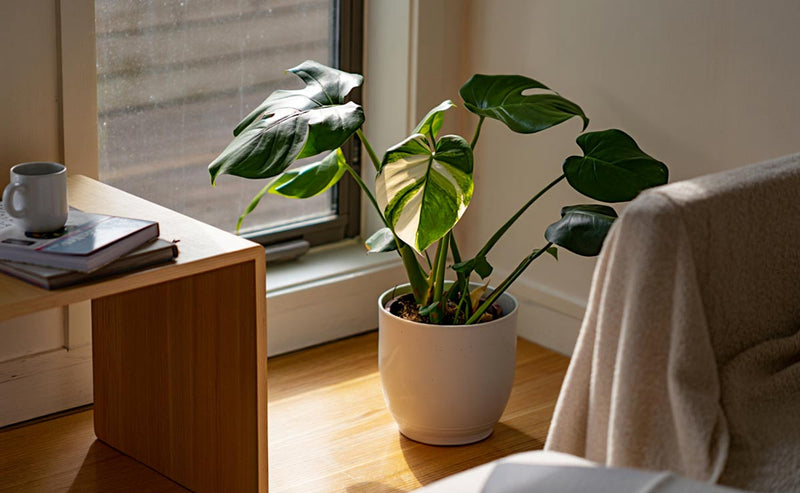Cultivate Vibrant Variegated Plants at Home

Table of Content
Introduction
Variegated plants are like nature's artwork, each one with its own unique pattern of colors that can instantly brighten up any space. These beauties aren't just about looks; they tell a story of nature's creativity and sometimes even a bit of luck. When I first stumbled upon a Monstera Deliciosa 'Albo', I was struck by its dramatic white patterns against lush green leaves. It felt like finding a hidden treasure in a sea of green. That moment sparked my love for variegated plants.
The magic of variegation isn't just about color. For me, it's the rewarding challenge of keeping those swirls and splashes vibrant. Many people love them because they bring a sense of uniqueness to any space. Whether you’re just getting into houseplants or have a full indoor jungle, learning the ins and outs of variegated care can turn your space into something really special.
Common Variegated Plants You'll Love
If you're starting or expanding your collection, here are a few of my favorites and why I love them.
1. Monstera Deliciosa 'Albo': This one is a true showstopper. The bold white variegation floating through the deep green leaves gives it an instant wow factor. It's rare, which makes it even more fun to grow.
2. Philodendron Birkin: I’m a big fan of this one because of its creamy white pinstripes that shoot out like stars from the center of each leaf. It’s pretty easy to care for, which is great if you're just getting started.

3. Variegated Rubber Plant: This variety adds softness with its pale green leaves edged in cream. It’s sturdy too. If you tend to forget to water now and then, this plant won't hold it against you.
4. Variegated ZZ Plant: I really appreciate how this one is both low-maintenance and eye-catching. The soft yellow swirls on its otherwise green leaves keep things interesting. It survives even when I miss watering—or let it go a little too long between drinks.
These plants don’t just offer color variety. Their care routines have their own quirks, which I find fun to work with. When you see those bright patches stay put or come in stronger, it feels like a win.
How to Maintain and Enhance Variegation
To keep those dreamy patterns looking their best, you'll want to pay attention to a few key care steps.
Light is huge. Variegated plants need more light than the typical green types. That white or pale coloring can’t photosynthesize like green leaves, so these plants depend more on the green areas. I usually place mine in bright, indirect sunlight—east or south-facing windows work great when softened by sheer curtains.

Watering is another area where I stay consistent. Too much, and root rot kicks in. Too little, and you might see dull coloring or leaf loss. I like to let the top inch of soil dry before I water. I usually check with my finger rather than rely on a set schedule. It keeps me tuned in to what my plants actually need.
Pruning and propagation also help more than people might think. When an older leaf starts fading or turning fully green, trimming it encourages new, healthy, and hopefully variegated growth. If I’m propagating, I always use a cutting that has visible variegation—it gives me a better starting point for new plants.
Fertilizer makes a big difference too. I stick with a balanced, diluted option during the growing months. It gives just enough nutrients without overwhelming the plant.
Busting Myths About Variegated Plants
Too many folks give up on variegated plants before giving them a real shot. There are some myths out there that just aren’t true.
One is that they’re super fragile. While it’s true that they need more light and a little extra attention, I’ve found that many are just as tough as any other leafy plant once you figure out their rhythm.
Another myth is that you can somehow force variegation by using special sprays or magic soil. The truth is, those beautiful color patterns are built into the plant’s genes. You can maintain them through good care, but you can’t make them appear if they’re not in the plant’s DNA.
And no, all hope isn’t lost if your plant starts producing solid green leaves. I’ve had that happen, and with a little pruning and correcting the light situation, my plants have bounced back with fresh, variegated growth.
Special Products to Support Variegation
There are a few items I personally keep around that make a big difference.
For soil, I like to make my own mix. I start with basic potting soil and add orchid bark and perlite. This keeps it airy so the roots don’t sit in too much water.
In terms of nutrients, I use a liquid fertilizer made for indoor foliage. I apply it every few weeks during the spring and summer when my plants are actively growing. It seems to boost new growth and keeps the leaves strong and colorful.
One last item I love is my moisture meter. It’s a simple tool, but it takes the guesswork out of watering. I use it especially on plants that are in deeper pots or ones that don’t show signs of thirst right away. It’s saved me from overwatering more times than I can count.

Turning Your Home Into a Variegated Plant Haven
Adding variegated plants to your space is one of the easiest ways to uplift your environment. I like placing mine where they can catch the eye—think coffee table centers, windowsills, or even mounted wall shelves in the kitchen.
Lighting plays into this again. Make sure they’re close to a good light source so those colors pop and stay strong. Rooms with east- or south-facing windows are great, but even north ones can work if you’re using a plant light.
Don’t ignore the containers, either. Plain pots can really let the leaves do the talking, while colorful or textured planters can amplify the vibe. Mixing leaf shapes and patterns in one corner can turn an overlooked room spot into a real design moment.
Swap plants around every couple of months or follow the light as the seasons shift. I do this all the time to keep them thriving and my space feeling fresh.
Growing Your Variegated Collection with Confidence
Adding variegated houseplants into your indoor world is like bringing art to life. They're eye-catching, yes, but they also offer a challenge that teaches you to tune in and care more mindfully.
You don’t need to be perfect. I’ve made plenty of mistakes with mine. But learning the sweet spot between light, water, and nutrients gives these plants a chance to really show what they can do.
Stick with what works for your schedule and space. Start simple, watch how your plants respond, and adjust as you go. Every new growth with those creamy swirls or bold white blotches feels like a reward.
Let your love for these plants grow naturally, and pretty soon, you’ll find yourself confidently picking out the next one to add to your collection.
Looking to make your home a lush, serene oasis with plants that are both stunning and easy to maintain? Discover how easy houseplants for beginners can simplify your care routine and bring more confidence to your plant parenting. At Houseplant Resource Center, we offer practical tips and guidance so you can nurture your variegated collection and turn any room into a green retreat.








